Menus
- The best motorcycles for fun on bends
- Handling test
- KTM 390 Duke
- Data, facts and evaluation
- Triumph Street Triple
- Data, facts and evaluation
- Ducati Hypermotard SP
- Data, facts and evaluation
- Honda CB 1000 R.
- Data, facts and evaluation
- Aprilia Tuono V4 R APRC
- Data, facts and evaluation
- BMW S 1000 RR
- Data, facts and evaluation
- Readings
- Performance measurement
- Tips, tricks and conclusion
- Driver opinions
- MOTORCYCLE conclusion
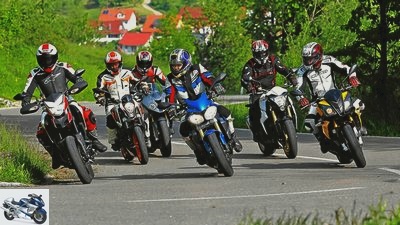
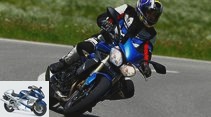

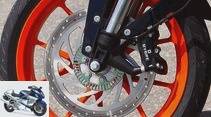
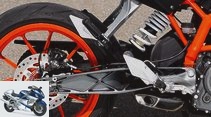
33 photos
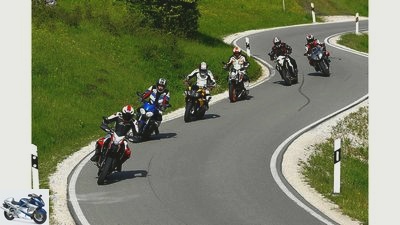
1/33
Ducati Hypermotard SP, Triumph Street Triple, Aprilia Tuono V4 R APRC, KTM 390 Duke, Honda CB 1000 R and BMW S 1000 RR in the handling comparison test.
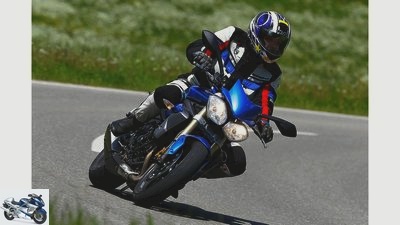
2/33
Triumph Street Triple 190 kilograms, 106 hp, 8090 euros. A lot of motorcycle for little money.

3/33
Just don’t push. When six motorcycles fit in one photo, things get tight.
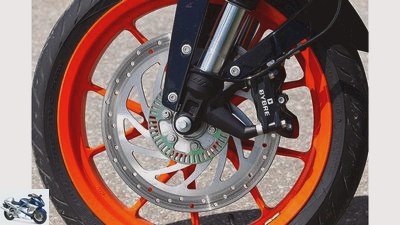
4/33
The Indian Bybre brake caliper requires firm grip and is prevented from locking by a Bosch ABS.
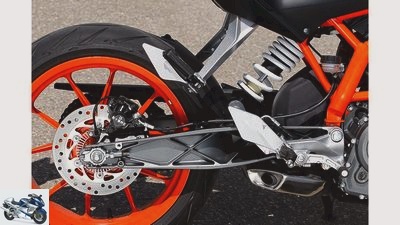
5/33
The one-piece, outwardly open cast rocker arm and the simple shock absorber with progressive spring save weight and manufacturing costs.
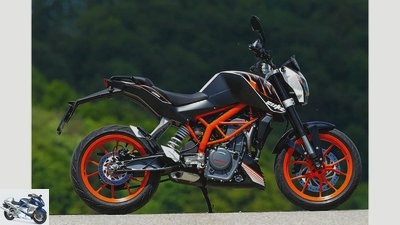
6/33
KTM 390 Duke 152 kg, 44 hp, 4995 euros. The new discovery of lightness.
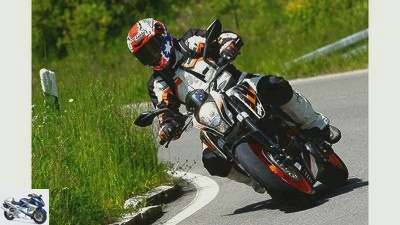
7/33
KTM 390 Duke 152 kg, 44 hp, 4995 euros. The new discovery of lightness.
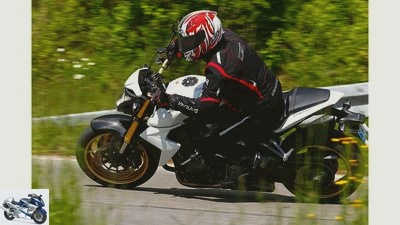
8/33
Honda CB 1000 R 125 hp, 220 kg, 11 490 euros. A solid driving machine in a chic outfit.
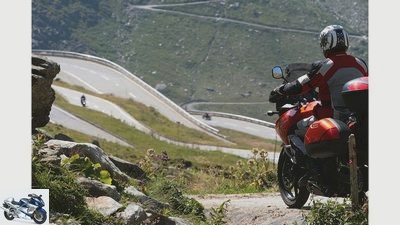
9/33
Motorcycling is fun on such routes.
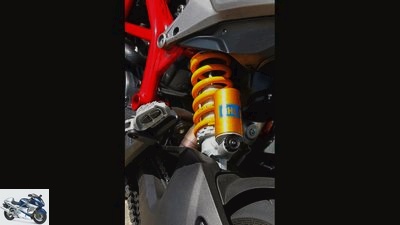
10/33
The finest chassis components from Marzzochi in the front and Ohlins in the rear. Unfortunately, the vote does not harmonize.
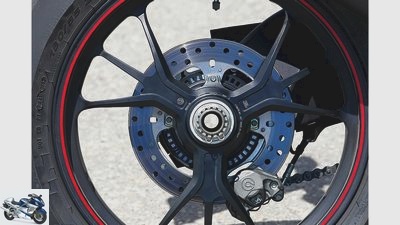
11/33
For technology freaks: single-sided swing arm with central nut for the fine Marchesini aluminum forged wheel.
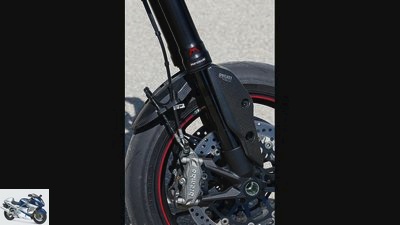
12/33
The finest chassis components from Marzzochi in the front and Ohlins in the rear. Unfortunately, the vote does not harmonize.
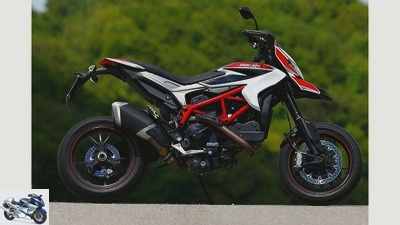
13/33
Ducati Hypermotard SP 195 kg, 110 PS, 14,590 euros. Italians know how to sell dreams.
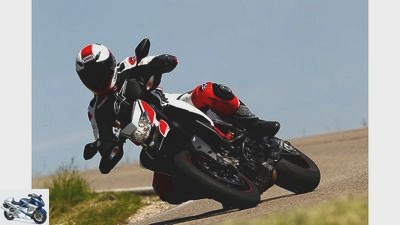
14/33
Ducati Hypermotard SP 195 kg, 110 PS, 14,590 euros. Italians know how to sell dreams.
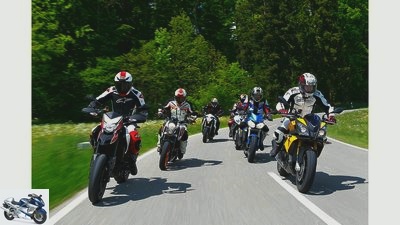
15/33
Ducati Hypermotard SP, Triumph Street Triple, Aprilia Tuono V4 R APRC, KTM 390 Duke, Honda CB 1000 R and BMW S 1000 RR in the handling comparison test.
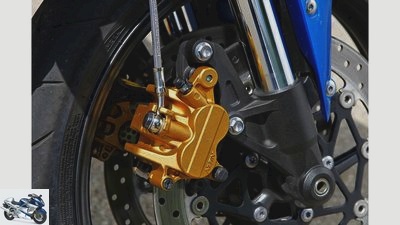
16/33
Inexpensive but completely sufficient floating caliper brakes, for an additional charge of 400 euros also with ABS control.
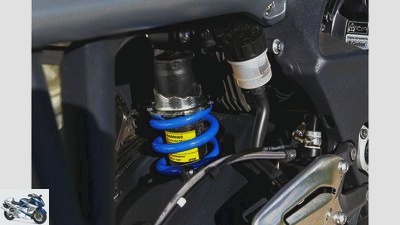
17/33
Europe has to save: central spring strut without damper adjustment and unfortunately too softly tuned.

18/33
Triumph Street Triple 190 kilograms, 106 hp, 8090 euros. Lots of motorcycles for little money.
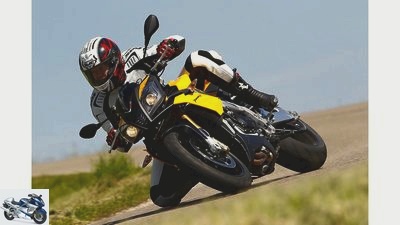
19/33
Aprilia Tuono V4 R APRC 212 kg, 167 hp, 14 903 euros. The superbike with a fantastic V4 engine.

20/33
“What are you crouching in the meadow ond the grass?” Complains the farmer.
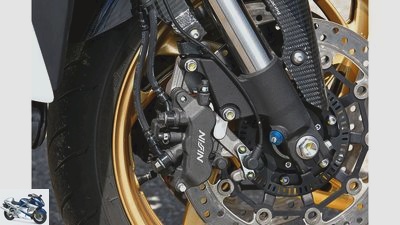
21/33
Elaborate: the combined Honda brake, naturally with ABS, and fully adjustable USD 43 fork.
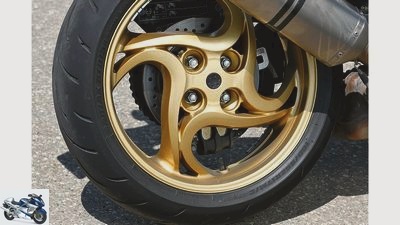
22/33
The single-sided swing arm creates space for the silencer. Baroque spoke design on the rear wheel – that’s better.
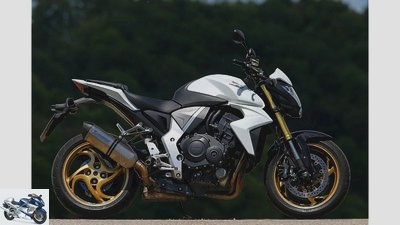
23/33
Honda CB 1000 R 125 hp, 220 kg, 11 490 euros. A solid driving machine in a chic outfit.
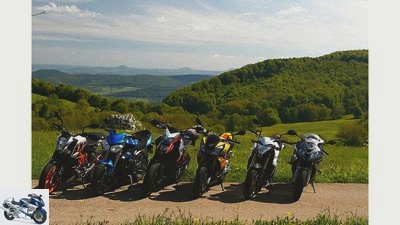
fact
24/33
Ducati Hypermotard SP, Triumph Street Triple, Aprilia Tuono V4 R APRC, KTM 390 Duke, Honda CB 1000 R and BMW S 1000 RR in the handling comparison test.
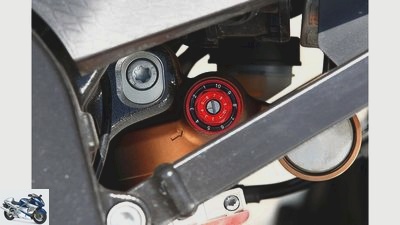
25/33
Clear damper adjustment, but with only ten steps, height adjustment of the strut on the upper bolt.
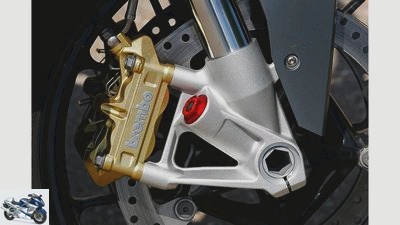
26/33
Euro-Fighter: Sachs fork with Brembo brakes – only the BT 16 per Bridgestone tires come from Japan in this case.
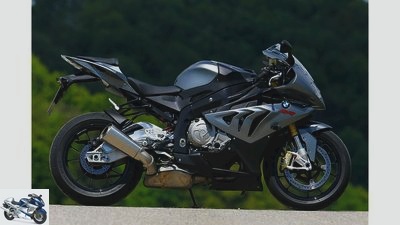
27/33
BMW S 1000 RR 209 kg, 193 hp, 16,850 euros. Mia san mia – and build the most powerful sports motorcycle.
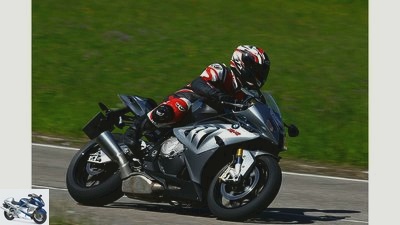
28/33
BMW S 1000 RR 209 kg, 193 hp, 16,850 euros. Mia san mia – and build the most powerful sports motorcycle.
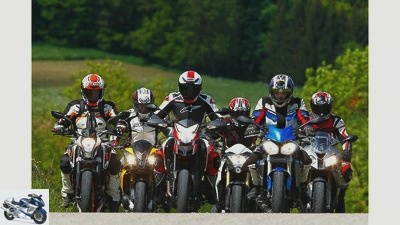
29/33
When headlights become faces: recognition as a trademark.

30/33
The fully adjustable shock absorber with easily accessible locknuts is in the beautifully made aluminum swing arm.
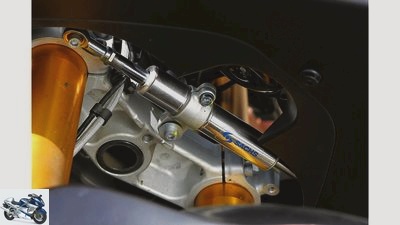
31/33
Better safe than sorry: the steering damper on the lower triple clamp is not a luxury, but a precaution.
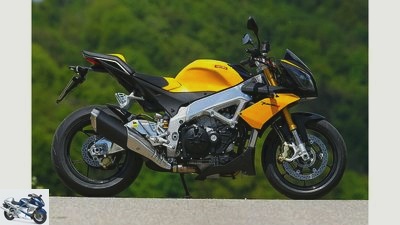
32/33
Aprilia Tuono V4 R APRC 212 kg, 167 hp, 14 903 euros. The superbike with a fantastic V4 engine.
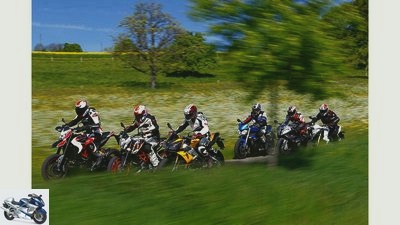
33/33
Ducati Hypermotard SP, Triumph Street Triple, Aprilia Tuono V4 R APRC, KTM 390 Duke, Honda CB 1000 R and BMW S 1000 RR in the handling comparison test.
Six motorcycles in the handling test
The best motorcycles for fun on bends
If you want to curve quickly through the landscape, you can save your savings on nimble, handy motorcycles. With six test persons who were born with handiness, MOTORRAD reveals the secret of handling, driving pleasure and the much-cited drivability.
Handling test
Hdiversity is at the top. Not only in the points evaluation of MOTORRAD the chapter “Chassis” is introduced with the criterion of maneuverability, a lot of motorcyclists get sparkling eyes with this catchphrase. Why? Probably because being light-footed on two wheels comes closest to the human dream of flying. There is no better feeling than sailing through the landscape with the least amount of effort and apparently freed from gravity. In order to be able to enjoy this exhilaration without compromising, in addition to the handiness, which is primarily characterized by a smooth steering feel, half a dozen other parameters determine the more or less undisturbed fun on bends.
Buy complete article
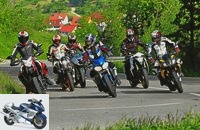
Six motorcycles in the handling test
The best motorcycles for fun on bends
A colorful mix – the test field for the kings of curves
- With the small 390, KTM has the best cards to lift its youngest offspring onto the throne despite the lack of performance.
- Triumph also looked at the crown of the curve king and pushed the Street Triple 675 without an “R” to the start.
- The Ducati Hypermotard SP is in the starting blocks to really fry the rest of the pack.
- Honda makes street fighters with the CB 1000 R..
- Aprilia Tuono V4 R: currently the fastest supersport motorcycle with wide handlebars.
- BMW S 1000 RR: The bestseller in the sports segment represents the handlebar fraction in the handling test.
With this ensemble, one or the other reader will certainly wonder where the comparability should lie. A 5,000 euro cheap KTM 390 for high-tech rockets for the price of three KTM? Exactly, because MOTORRAD does not ask for lap record and top speed values, but for the greatest possible driving and cornering fun. And that doesn’t necessarily have to go hand in hand with power and high-tech – as we will learn at the end of the story.
“What are you crouching in the Wies’ rum and spoiling the grass, “complains the farmer .
In order to get on the track of the handling and cornering qualities, the six test persons go through the MOTORCYCLE handling course, on which pretty much all typical rural road sequences are simulated. Tricky double curves, a darned tight bend at walking pace and precisely lined up S-curves as a slalom. Everything, of course, meticulously measured, analyzed and evaluated via a 2-D data recording. The requirement for the two test drivers: no hanging-off driving style in the last groove, but a normal sitting posture and increased speed on the country road.
Second part: Whizzing over the most beautiful motorcycle routes between Stuttgart and Lake Constance for a day without being fussy and free from any measurements Drive until your bum smokes and shortly before sunset you can see which of the six street sweepers is in the best mood.
KTM 390 Duke
152 kg, 44 hp, 4995 euros. The new discovery of lightness.
KTM 390 Duke: 152 kilos – is easy to handle?
The competition should really grapple with these key data. When pushing, turning and maneuvering for the first time, the assumption is fed: It couldn’t be more handy. Unfortunately, the astonishing lightness of the KTM disappears when things get dynamic. First, you sit too much “on the handlebars", which requires a certain permanent support force, and secondly, the simple spring elements allow a lot of movement in the chassis. Especially at the back, the curve flea sags when jagged cornering, whereupon the front likes to seek the distance and the 390 KTM understeer. Not dramatically, but in such a way that at the apex you have to determine the direction via an emphatic steering impulse to the outside of the curve. Which can be achieved with a little practice. On the other hand, the KTM conjures up sudden changes in lean angle in the moderate range of up to around 35 degrees with the expected nonchalance on the asphalt.
Footrests placed far back disturb
The footpegs placed far to the rear are annoying, which have to be subjected to a cutting process during the slalom test and in the circular path and which limit the possible lean angle of the non-slip Metzeler M5 Sportec tires. The test drivers, spoiled by the ample engine power, also have to practice with the small four-stroke engine. Because cornering requires not only precise steering, but also a reliably pushing motor that helps man and machine out of a lean position at the right time and with spontaneous acceleration. The exactly 373 cubic centimeter engine should like to work a little more lively.
However, when the aisles are diligently sorted and painless filming persuades the 44 hp to work, the KTM does not have to hide. Especially since the pure driving performance makes you sit up and take notice: from zero to 100 km / h in 5.3 seconds and a brisk 160 km / h top speed – Chapeau. When braking with the front Bybre brake caliper, an Indian offshoot of the brake specialist Brembo, you have to grapple. Sometimes a little too much, because the standard Bosch ABS intervenes efficiently and in good time.
Data, facts and evaluation
The one-piece, outwardly open cast rocker arm and the simple shock absorber with progressive spring save weight and manufacturing costs.
Motor / drive
Single-cylinder four-stroke engine, displacement 373 cm³, output 32.0 kW (44 PS) at 9500 / min, torque 35 Nm at 7250 / min, six-speed gearbox.
landing gear
Tubular steel frame, upside-down fork, Ø 43 mm, spring travel 150 mm, two-arm swing arm made of aluminum, central spring strut directly hinged, spring travel 150 mm adjustable spring base, tires, 110/70 ZR 17; 150/60 ZR 17, ABS, single disc brake at the front, Ø 300 mm, four-piston fixed calipers; Rear disc brake, Ø 230 mm, single-piston floating caliper.
Chassis data
Wheelbase 1367 mm, steering head angle 65.0 degrees, caster 94 mm, weight distribution 51/49%, weight with a full tank * 152 kg.
Price: 4995 euros
Additional costs: around 200 euros
Performance
Top speed *: 160 km / h
Acceleration: 0-100 km / h in 5.3 seconds; 0–140 km / h in 10.8 seconds
Pulling speed: 60-100 km / h in 7.1 seconds; 100–140 km / h in 7.1 seconds
rating
It’s great that there are motorbikes that teach us what seemed to be lost for a long time: the art of not losing momentum. If you have what it takes, you can enjoy the lightness of the KTM 390 on country roads of all kinds.
* MOTORCYCLE measurements
Triumph Street Triple
190 kilograms, 106 hp, 8090 euros. Lots of motorcycles for little money.
Triumph Street Triple: the fine English way to iron the curves
Actually, nothing can go wrong. The frame and motor are borrowed from the top of the class, the Daytona 675 super sports car, the seating position is crisp and compact and the wide handlebars guarantee even easier steering, not to mention the powerful three-cylinder engine. First surprise: the Pirelli Diablo Rosso Corsa tires have to be warmed up thoroughly, otherwise the Streety will rock and roll miserably around the bends. Second surprise: the spring / damper set-up was too far on the comfort side for a sporty naked bike. At the front it is on the block when braking, at the rear it sometimes swings funny and, if the driver is in a lot of pressure, goes deep in the suspension.
The chiropractor doesn’t have to help with pointing
The old wisdom that large movements of the spring devour handiness is confirmed by this vote of triumph. In the approach a super nimble motorcycle, you have to recognize on the committed ride that the Streety also likes to take the slightly wider curve and sometimes gets out of step in the groovy slalom. Because there is nothing to adjust apart from the spring preload on the shock absorber, the test team uses a spring adjusted to level three, which keeps the rear ten millimeters higher and the Triumph on track. Thanks to the decent lean angle and the – when warmed up – non-slip Pirellis, the Triumph cannot be dependent on the rest of the pack. Which of course is also due to the robust start of the highly entertaining, 106 hp three-cylinder. And the relaxed seating position, thanks to which you don’t have to be picked up by a chiropractor from the bike even after long stretches.
With her simple but sufficiently effective floating caliper brakes, which can be upgraded with an ABS if desired, the little English girl is preparing to inspire newcomers and those returning to the sport. Especially since the petite motorcycle with a slim 190 kilograms is one of the lightest mid-range motorcycles. This does not compensate for the weaknesses in the spring / damper coordination, but makes everyday maneuvering child’s play.
Data, facts and evaluation
Europe has to save: central spring strut without damper adjustment and unfortunately too softly tuned.
Motor / drive
Three-cylinder four-stroke in-line engine, displacement 675 cm³, output 78.0 kW (106 hp) at 11,850 rpm, torque 68 Nm at 9750 rpm, six-speed gearbox.
landing gear
Bridge frame made of aluminum, upside-down fork, Ø 41 mm, spring travel 115 mm, two-arm swing arm made of aluminum, central spring strut with lever system, spring travel 135 mm, adjustable spring base, tires, 120/70 ZR 17; 180/55 ZR 17, ABS, double disc brake at the front, Ø 310 mm, double-piston floating calipers; Rear disc brake, Ø 220 mm, single-piston floating caliper.
Chassis data
Wheelbase 1410 mm, steering head angle 65.9 degrees, caster 95 mm, weight distribution 52/48%, weight with a full tank * 190 kg.
Price: 8090 euros
Price test motorcycle¹: 8923 euros
Additional costs: around 395 euros
Performance
Top speed *: 226 km / h
Acceleration: 0–100 km / h in 3.5 seconds; 0-140 km / h in 5.7 seconds; 0-200 km / h in 12.9 seconds
Pulling speed: 60–100 km / h in 3.6 seconds; 100-140 km / h in 4.1 seconds; 140–180 km / one way 4.8 sec
rating
The small three-cylinder has retained its lovable character even in the inexpensive Street Triple version. The sporty, ambitious driver has to make compromises on the chassis, which also affect handiness.
* MOTORCYCLE measurements; ¹Price includes ABS (400 euros), instrument cover (219 euros), frame protectors (159 euros), rear swing arm stand mount (20 euros), chain fin below (35 euros)
Ducati Hypermotard SP
Ducati Hypermotard SP: red, classy, noble – and expensive
If that’s not the king of curves, who is? Super-light forged wheels, racing tires, noble chassis components, held together by a sparkling clean, fire-red tubular frame. Lord, who can say no? Who? Many of those who climb from the 910 millimeter high bench after extensive test drives and wonder where Ducati overshot the mark with this chassis. Well, the Pirelli Diablo Supercorsa SP tires have to be heated up here too – accepted. A bench that, with the immovable seat hollow, offers the driver little freedom of movement – also okay. Footrests that touch down relatively early – it doesn’t matter, they fold up. But the fact that the Marzocchi fork responds insensitively and still dips quickly when braking is not allowed with a high-tech component with carbon-coated dip tubes and x-fold damper adjustment.
Constantly demands steering corrections
The directly hinged Ohlins shock absorber on the single-sided swing arm is clearly too tight for this, which in combination results in an unbalanced spring balance. A clear plus point of the Hypermotard SP: the smooth steering and the resulting lightning-fast folding down in an inclined position, certainly a result of the easy-to-handle high center of gravity and the light forged wheels. However, when the Ducati is inclined, it looks wobbly from around 35 degrees, requires constant steering corrections and only gives the driver an average feedback from the front wheel. And why did Ducati also mount the handlebars in soft rubber elements, especially since the 821 engine is a supple, low-vibration fellow? All in all, every curve, every change of incline during the rapid canter, demands concentration in order to hit the desired line exactly. And yet, as a glance at the timesheet shows, the Hypermotard can be moved surprisingly quickly and hardly dependent on the others. Which shows what potential there is in her.
It’s actually a shame, because the almost perfect country road engine deserves a better chassis. Powerful acceleration, powerful pressure in the middle, unrestrained maneuverability when it’s pressed, and the vibrations finely tamed at all speeds. What remains is the lovable pulsing of the V2, framed by the rumbling and hammering from the somewhat too loud silencer. Here you go, dear Ducatisti, let your veteran chassis designers from the 916 era do it again and finally put this fine Desmo-Twin on an adequate chassis.
Data, facts and evaluation
Motor / drive
Two-cylinder four-stroke 90-degree V engine, displacement 821 cm³, output 81.0 kW (110 PS) at 9250 / min, torque 89 Nm at 7750 / min, three freely selectable performance variants, six-speed gearbox.
landing gear
Tubular steel frame, upside-down fork, Ø 50 mm, spring travel 185 mm, two-arm swing arm made of aluminum, central spring strut directly hinged, spring travel 175 mm, tires, 120/70 ZR 17; 180/55 ZR 17, ABS, traction control, double disc brake at the front, Ø 320 mm, four-piston fixed calipers; Rear disc brake, Ø 245 mm, two-piston fixed caliper.
Chassis data
Wheelbase 1505 mm, steering head angle 64.5 degrees, caster 104 mm, weight distribution 52/48%, weight with a full tank * 195 kg.
Price: 14 590 euros
Additional costs: around 305 euros
Performance
Top speed *: 220 km / h
Acceleration: 0-100 km / h in 3.3 seconds; 0-140 km / h in 5.5 seconds; 0-200 km / h in 13.7 seconds
Pulling speed: 60-100 km / h in 3.7 seconds; 100-140 km / h in 4.2 seconds; 140-180 km / h in 5.1 seconds
rating
A first-class V2 engine in a stylish, lavish chassis. Unfortunately, the capricious driving behavior and questionable ergonomics demand a lot from the Italo enthusiast. Ducati could do better than that.
* MOTORCYCLE measurements
Honda CB 1000 R.
125 hp, 220 kg, 11 490 euros. A solid driving machine in a chic outfit.
Honda CB 1000 R: Streetfighter as a ready-made product. Is that possible?
This works out. Get on, drive off and get on with it. Now nobody comes with the endless loop of characterless Japan trinkets just because a Honda works right away. What is reprehensible about it when the CB 1000 R scratches its notches in the third corner because you feel more comfortable and safe from a standing position than on any other motorcycle? And that with the old Bridgestone BT 15 rubbers on the rims. Just think about turning in, and – whoosh – the 220 kilograms sail like nothing around the corner, the CB 1000 R hits every vertex with an accuracy of five cent and keeps the track when driving out as if chiseled when the CB 1000 motor pushes that the chain crunches.
Lord, riding a motorcycle can be easy!
Lord, riding a motorcycle can be easy. Shaking the slalom loosely out of your sleeve, drawing fine scratch marks in the asphalt on the circular path as if in a circle and turning it around on the front wheel while spinning around the hairpin. The fly in the ointment: the BT 15 front tire, special code “L”, stands up sharply when braking in an inclined position. For this, the braking system with ABS decelerates fine and calmly on the country road as well as on the synthetic test track. Suitable for casual handling: the seating position. Sit on it, click into place, feel good. In jagged cornering as well as in the marathon stage. Just great.
Data, facts and evaluation
Elaborate: the combined Honda brake, of course with ABS, and fully adjustable USD 43 fork.
Motor / drive
Four-cylinder four-stroke in-line engine, displacement 998 cm³, output 92.0 kW (125 PS) at 10,000 rpm, torque 99 Nm at 7750 rpm, six-speed gearbox.
landing gear
Bridge frame made of aluminum, upside-down fork, Ø 43 mm, spring travel 120 mm, adjustable spring base, rebound and compression damping, single-sided swing arm made of aluminum, central spring strut, spring travel 128 mm, adjustable spring base, rebound damping, tires, 120/70 ZR 17; 180/55 ZR 17, ABS, double disc brake at the front, Ø 310 mm, six-piston floating calipers; Rear disc brake, Ø 256 mm, two-piston fixed caliper.
Chassis data
Wheelbase 1445 mm, steering head angle 65.0 degrees, caster 99 mm, weight distribution 49/51%, weight with a full tank * 220 kg.
Price: 11 490 euros
Price test motorcycle²: 13,462 euros
Additional costs: around 265 euros
Performance
Top speed *: 230 km / h
Acceleration: 0–100 km / h in 3.2 seconds; 0-140 km / h in 5.3 seconds; 0-200 km / h in 11.2 seconds
Pulling speed: 60-100 km / h in 3.7 seconds; 100-140 km / h in 3.5 seconds; 140-180 km / h in 4.1 seconds
rating
Powerful pressure from four cylinders, which in combination with a stable, precise steering and safe chassis leaves little to be desired and is equally good for experienced as well as for inexperienced users.
* MOTORCYCLE measurements; ²Price includes titanium look frame trim (105 euros), titanium look brake cylinder cover (47 euros), titanium look oil filter cover (37 euros), carbon fenders at the front and rear (608 euros),
Splash guard carbon look (219 euros), swing arm trim carbon protection (128 euros), Akrapovic slip-on system (794 euros), HRC tank pad (34 euros)
Aprilia Tuono V4 R APRC
212 kg, 167 hp, 14 903 euros. The superbike with a fantastic V4 engine.
Aprilia Tuono V4 R APRC: when the servant crushes the master
Do you have children, wife, friends? Are you very healthy and life-affirming? Then don’t mess with this monster. Go fishing, fly a kite or ride a motorcycle – but not with this Aprilia. Bad chassis, unstable, stubborn? No, on the contrary. This motorcycle is the animal par excellence. With this engine, the asphalt ripples, and when we speak of the possible handling king, we are also talking about the Aprilia Tuono V4 R. Deductions: The Aprilia also wears Pirelli Diablo Rosso Corsa, which do not like curves when cold. But it doesn’t matter, because the brute motor kneads the rubber in such a way that you can do without tire warmers.
Explore physical limits by all means
And then there’s no stopping it. Stability, steering precision, feedback and, last but not least, handiness set standards. The basic chassis data are anything but a hit: with a relatively heavy 212 kilograms, the Aprilia also rolls on a 190/55 slipper. With a 63 degree steering head angle combined with 107 millimeters of caster, the steering geometry is anything but aggressive. So what does it matter? Certainly the race-proven aluminum chassis with the compact V4 engine, the light forged wheels and the relatively short wheelbase of 1445 millimeters: Everything else will remain a factory secret in the Aprilia engineers’ safe. With a low-mounted tubular handlebar, the Tuono forces its master into a front-wheel-oriented sitting posture, which benefits the driving dynamics, but is detrimental to comfort.
But Aprilia does not accept such demands. The brutal performance explosion alone, which is accompanied by the roaring, loud V4 rumble from the silencer, makes it clear what this is about. Certainly not about relaxed country road surfing. Rather, it is about exploring physical limits by all means. Which is why the Aprilia Tuono allows maximum acceleration with efficient traction control and an automatic gearshift, but does without ABS. As I said: think twice before hooking up with this Italian monster.
Data, facts and evaluation
The fully adjustable shock absorber with easily accessible locknuts is in the beautifully made aluminum swing arm.
Motor / drive
Four-cylinder, four-stroke, 65-degree V engine, displacement 1000 cm³, output 123.0 kW (167 hp) at 11 500 rpm, torque 112 Nm at 9500 rpm, three freely selectable performance variants, six-speed gearbox, automatic transmission.
landing gear
Bridge frame made of aluminum, upside-down fork, Ø 43 mm, spring travel 120 mm, two-arm swing arm made of aluminum, central spring strut with lever system, spring travel 130 mm, tires, 120/70 ZR 17; 190/55 ZR 17, ABS, traction control, double disc brake at the front, Ø 320 mm, four-piston fixed calipers; Rear disc brake, Ø 220 mm, two-piston fixed caliper.
Chassis data
Wheelbase 1445 mm, steering head angle 63.0 degrees, caster 107 mm, weight distribution 50/50%, weight with a full tank * 212 kg.
Price: 14 903 euros
Additional costs: around 287 euros
Performance
Top speed *: 270 km / h
Acceleration: 0-100 km / h in 3.2 seconds; 0-140 km / h in 4.9 seconds; 0-200 km / h in 8.7 seconds
Pulling speed: 60-100 km / h in 3.8 seconds; 100-140 km / h in 3.7 seconds; 140–180 km / h in 3.8 seconds
rating
In the Tuono V4 R, which requires a gun license, Aprilia uses the purest racing technology for the engine and chassis and combines both elements to create the most radical driving machine in comparison.
BMW S 1000 RR
209 kg, 193 hp, 16,850 euros. Mia san mia – and build the most powerful sports motorcycle.
BMW S 1000 RR: the attempt to combine 200 hp and common sense
Let’s make it short. The BMW plays in a different league. The handlebar stubs a good ten centimeters narrower than the other five candidates, stooped posture, tight steering damper and a chassis that is more due to stability than agility. You really work hard in the country roads, persuade the S 1000 RR to wag around bends with physical work, but in return you get back a maximum of sufficient handiness. This projectile is designed to convert the almost 200 hp into fast lap times on GP circuits. Or deliver a few good lap times on the slalom course. On the winding country roads between the Swabian Alb and Lake Constance, on the other hand, you feel as if you are storming the Zugspitze on a Mount Everest expedition. Too much of everything, just too little of the casual handiness.
Country roads of this world are not up to the BMW power
But everything is on board that makes fast travel safer. ABS, traction control, rollover protection, power delivery as required. In terms of cornering stability, feedback, steering precision on the level of the Aprilia Tuono, the exuberant driving pleasure on the country road does not want to set. I think the whole thing will be postponed to Monday. There is race training in Hockenheim. Then the wide-handlebar combo can happily compete again.
The biggest problem for the BMW: The country roads of this world are not up to the BMW power, and even some highways are too short when the four-cylinder unpacks the hammer. We leave it at that: a classy racing athlete who doesn’t have to hide in any discipline. But the BMW is not made for the joy of going around corners on the country road.
Data, facts and evaluation
Clear damper adjustment, but with only ten steps, height adjustment of the strut on the upper bolt.
Motor / drive
Four-cylinder, four-stroke in-line engine, displacement 999 cm³, output 142.0 kW (193 hp) at 13,000 rpm, torque 112 Nm at 9750 rpm, four freely selectable performance variants, six-speed gearbox, automatic transmission.
landing gear
Bridge frame made of aluminum, upside-down fork, Ø 46 mm, spring travel 120 mm, two-arm swing arm made of aluminum, central spring strut with lever system, spring travel 130 mm, tires, 120/70 ZR 17; 190/55 ZR 17, ABS, traction control, double disc brake at the front, Ø 320 mm, four-piston fixed calipers; Rear disc brake, Ø 220 mm, two-piston fixed caliper.
Chassis data
Wheelbase 1423 mm, steering head angle 66.0 degrees, caster 99 mm, weight distribution 52/48%, weight with a full tank * 209 kg.
Price: 16850 euros
Price test motorcycle³: 17,750 euros
Additional costs: around 390 euros
Performance
Top speed *: 299 km / h
Acceleration: 0–100 km / h in 3.2 seconds; 0-140 km / h in 4.6 seconds; 0-200 km / h in 7.2 seconds
Pulling speed: 60-100 km / h in 3.3 seconds; 100-140 km / h in 3.0 seconds; 140–180 km / h in 3.0 seconds
rating
Concentrated power and a stable, safe chassis cannot hide the fact that thoroughbred handlebar bikes do not necessarily set the tone on country roads.
* MOTORCYCLE measurements; ³Price including DTC (335 euros) and automatic switch (365 euros), heated grips (200 euros)
Readings
BILLION
The measured values from our comparison test.
What actually is handiness? We say there are forces and moments that can be measured. For example, using strain gauges on the handlebars that record the force introduced. But some riders think it is really great when, through a certain amount of steering resistance, you can feel that you are consciously steering the motorcycle. And the term handiness is already being used in the feedback criterion.
For this test, we sent two test drivers on a familiar handling course, with the task of assessing the six machines according to purely subjective criteria. Without acrobatic hanging-off and in the safety area that a life-affirming person prefers on the country road. Well, a bit more jagged can be on the closed and with plenty of run-off route.
The surprising thing is that the cornering speeds and maximum inclinations of around 45 degrees are the same with almost all machines. The big difference is the subjectively applied risk and the concentration. The “Slalom” section in particular works best with motorcycles, which, in addition to the much-invoked maneuverability, hit the vertices with fine steering precision. Because if you are carried out onto the long track at the beginning of the long series of bends, you will involuntarily get tangled in the following S and dramatically lose cornering speed. The clear winner when it comes to the feel-good factor: Honda CB 1000 R followed by the Triumph Street Triple – provided the tires are warm. Nice and, despite a few chassis defects, a really fun treat: the KTM 390. Razor-sharp corner sharpeners like the Aprilia Tuono V4 R only work if the driver is unconditionally involved. It becomes very difficult with the Ducati, which has to be handled with tweezers in order not to fall into an annoying fuss because of its generally good handling.
At first glance, it is astonishing how small the differences in the lap times are. Even the 44 hp KTM loses less than two seconds on the barbaric Aprilia Tuono. So it shouldn’t come as a surprise if you can’t get the enduro rider who knows the area to die out of your rear-view mirror while riding your familiar motorcycle on a brisk alpine ride. But the bottom line is that it is completely sausage. At the end of the day, what counts is the fun and joy of cornering.
Performance measurement
BILLION
The performance measurement from our comparison.
The Honda four-cylinder engine (green) shows where the hammer hangs and applies the greatest torque to the crankshaft up to 8000 rpm. The Aprilia V4 is similarly good, but clearly more spectacular when driving because it is also louder. What the BMW S 1000 RR (light blue) fires at the top should be saved for the racetrack.
Perfect for the country road
Perfect for the country road, Triumph (blue) and Ducati (red) build a clean, even torque plateau that feels just as calm but powerful when driving. The KTM (orange) hangs a little tough in the Nm hole below 6500 rpm, then it’s off. With 46 hp, the 390 stands at attention in the forage.
Tips, tricks and conclusion
Jahn
Handiness and steering precision have to come together.
The most beautiful weather, great motorcycle roads and still the feeling of liberated weightlessness does not want to come? Then check whether something is wrong with your motorcycle or your driving style.
Theory makes you safe
Find out about the theoretical basics
for safe cornering. For example, by reading from the 2013 special issue “MOTORRAD COACH, better driving”, which you can get from newsagents or by calling 07 11/1 82-14 44. Also highly recommended: The DVD “Motorcycling, good and safe”, which is available from the Institute for Two-Wheeler Safety (ifz.de) for 19.90 euros.
Practice makes you even safer
Especially after this long winter, many people lack driving experience. Inquire with the MOTORRAD action team for an appointment for corner training, which offers compact and very efficient training courses on great routes by trained instructors. Information by phone 0711 / 182-1977 or www.motorradonline.de/actionteam. Many race training organizers also offer instructor-led curve training.
Fear of leaning
Often a real banking blockage creeps in due to a lack of driving experience. You don’t dare to incline more than 20 or 25 degrees. In order to break through this fear, only iron training on an open area or a very clear curve route helps. Important: drive the tires warm and make sure that the grip of the warm tires allows much more lean angle than you can drive.
Wrong choice of line
If you have the feeling that you are running out of road at the end of the curve and you have to force the motorcycle into an incline, consciously try to turn in later at the corner entrance and to set the apex, i.e. the innermost point on the curve, at the earliest after half the curve radius. If you turn in too early, the motorcycle at the exit will be driven onto the opposite lane or the edge of the lane.
Only those who seek will find
There are plenty of beautiful, curvy motorcycle routes, but you have to find them. Therefore, thorough planning with road maps on a scale of no more than 1: 150,000, even better with 1: 50,000 cycling maps, is recommended.
Tires and air pressure
If you like fast handling, you should mount appropriately designed tires. Information on this is available from the tire tests or motorcycle-specific tire recommendations in MOTORRAD. And before you complain about the installed tires: check the air pressure. Too little makes the motorcycle sluggish and spongy, and wear and tear increases.
Spring preload and balance
The negative spring deflection measured on the rear wheel with the driver should not be more than 40 millimeters on road machines. If the motorcycle hangs lower at the rear, handiness and steering precision suffer, especially when exiting a curve (understeer).
Everything is under control?
If the foot pedal and handles do not fit in angle and reach, you will cramp when cornering. Check that all controls are conveniently close at hand or foot and can be operated without twisting. The gearshift and foot brake lever should be adjusted so that the foot rests loosely.
When it jerks and jerks when accelerating
Hard load changes can totally ruin the curve line. In order to achieve as smooth a transition as possible when applying the throttle, reduce the play in the throttle grip to almost zero and reduce the chain slack without overstretching the chain.
Steering head bearing incorrectly adjusted
If they are set too tightly or even run in, such steering head bearings cause wobbly, unstable cornering behavior. The steering must – completely relieved – fold in to the left and right without resistance and must not lock in the straight-ahead position.
Driver opinions
Roman Engwer (Motorbike Test Trainee)
"What a sextet! All great bikes, but my handling hit: the CB 1000 R. You can really let it rip from the first corner on it. It drives easily, neutrally, precisely – and quickly. The wobbly Hypermotard is the opposite of the Honda, needs way too much attention."
Georg Jelicic (test driver motorcycle)
"The KTM a little tighter and it would be my cornering king. Similar to the Triumph, which scores with the strong triple and peppers around the corners as finely as the absolutely neutral Honda. With the greedy Aprilia – whoops – the driver’s license is gone and the Ducati engine is as good as the chassis is tricky. BMW? First choice on Mondays in Hockenheim."
Werner Koch (Editor Motorcycle)
"The time for super sports cars on the road is over. What else should come? 250 hp and five kilograms of electronics rubbish? Back to the roots, crisp driving machines with technology you can touch. My very personal rating: CB 1000 R, Tuono, Street Triple, 390 Duke, S 1000 RR and most recently the capricious Hypermotard SP."
MOTORCYCLE conclusion
The agile naked bikes are slowly overtaking the pure super athletes.
One thing is certain: the class of bare, agile motorcycles outstrips pure super athletes. Why bend over when you can iron the handlebars with an Aprilia Tuono comparatively comfortably? But the Triumph Street Triple and the KTM 390 also prove that with little money and, in the case of the KTM, with less performance, highly dynamic leisure activities are possible. A trend that also allows you to enjoy the weightlessness in the curve maze without marginal inclines. Honda has a sharp arrow in its quiver for its renegade CBR 1000 pilots with the CB 1000 R, only Ducati now has to get the brilliant 821 engine going.
Related articles
-
Comparison test of the 1000 super sports car in 2006
fact Comparison test of the 1000 super sports car in 2006 The show must go on The mystery repeats itself. Whenever we think that nothing is going up, the…
-
Comparison test: Germany is looking for the superbike
Jahn 42 photos Jahn 1/42 Top handling and transparent feedback are what make the BMW S 1000 RR. It also owes a lot to the electronic tools. Jahn 2/42…
-
Comparison test Honda Fireblade, VTR 1000 SP-2
Artistic comparison test Honda Fireblade, VTR 1000 SP-2 Everything stays different Honda is the only motorcycle manufacturer to produce two 1000cc super sports …
-
Comparison test of the sports tourers from BMW and Honda
fact 12th photos fact 1/12 Top brakes: radially screwed six-piston stoppers, ABS and integral actuation. fact 2/12 Builds compact and very narrow: the…
-
Comparison test of the 1000 super sports car, part 1
Jahn Comparison test of the 1000 super sports car, part 1 The full program Lean, strong, ready for attack, the Suzuki GSX-R 1000 completes the field of…
-
90 hp naked bikes in a comparison test
fact 27 photos fact 1/27 One look at the performance diagram and it becomes clear: Even within the 90 hp middle class, there are worlds between the…
-
Comparison test Ducati 916 Biposto, Honda CBR 900 RR and Triumph Daytona T 595
Comparison test of the Ducati 916 Biposto, Honda CBR 900 RR and Triumph Daytona T 595 fire and flame It had to happen that way. Everyone has written it,…
-
Comparison test of the 600 super sports car
fact Comparison test of the 600 super sports car, Honda CBR 600 RR, Kawasaki Ninja ZX-6R, Suzuki GSX-R 600, Triumph Daytona 675, Yamaha YZF-R6 Street…
-
Comparison test of the 1000 super sports car
Jaime de Diego 38 photos fact 1/38 Yamaha charges 14,895 euros for their completely new R1 super sports bike. fact 2/38 Even without ABS, the Fireblade…
-
Comparison test Aprilia, Ducati, Kawasaki, KTM and Triumph
Artist Comparison test Aprilia, Ducati, Kawasaki, KTM and Triumph Cool naked bikes Minimalistic, aggressive, greedy and cool ?? Naked bikes focus the…